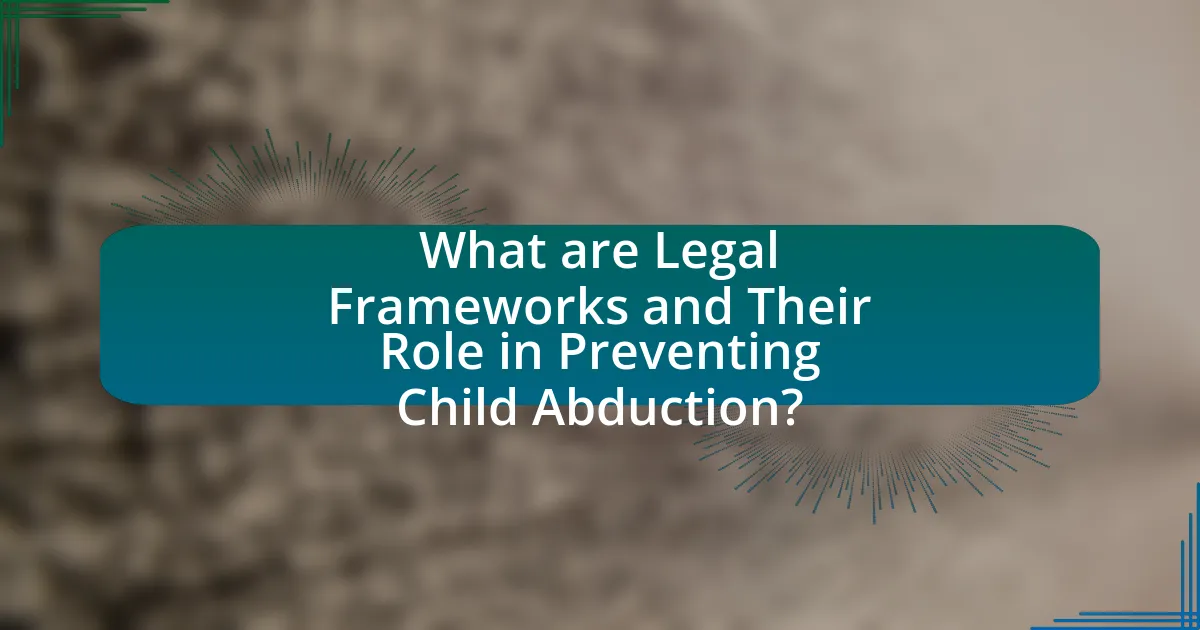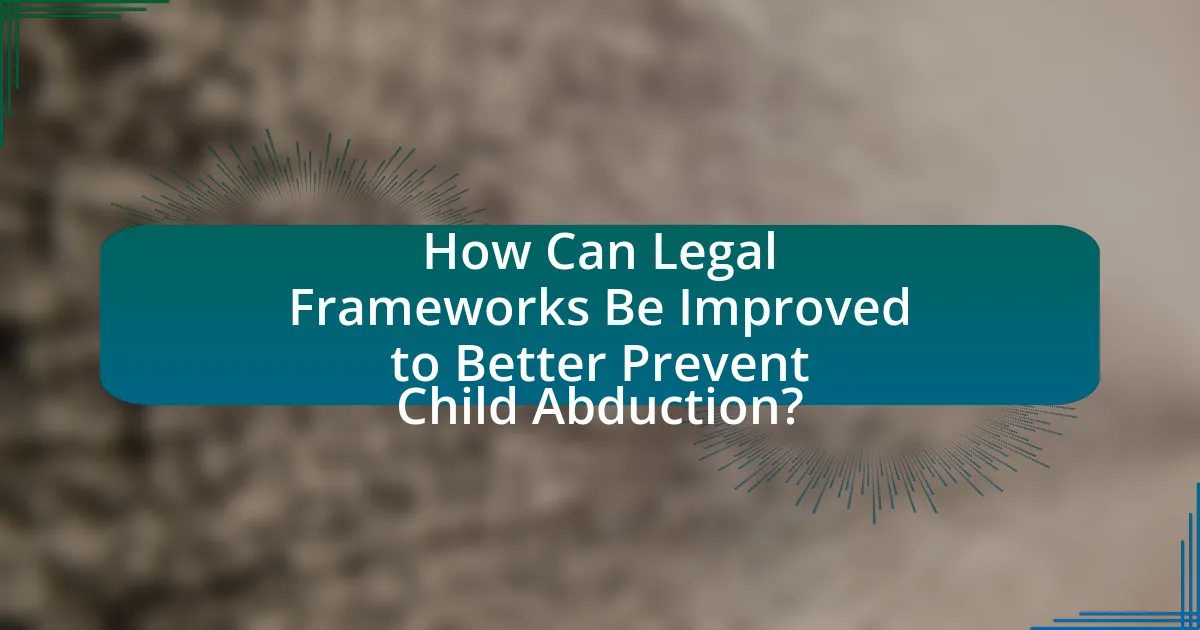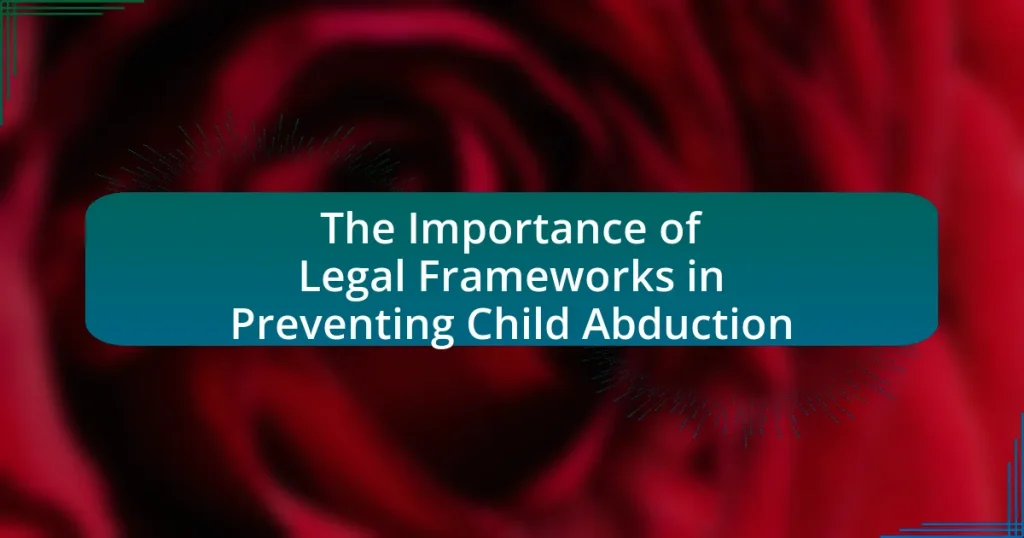Legal frameworks are essential systems of laws and regulations designed to protect children from abduction and other unlawful actions. This article examines the role of these frameworks in preventing child abduction, highlighting specific laws such as the Hague Convention on the Civil Aspects of International Child Abduction and national statutes that criminalize parental kidnapping. It discusses how legal frameworks contribute to child protection, the importance of international cooperation, and the impact of non-governmental organizations in advocating for stronger laws. Additionally, the article addresses gaps in existing legal frameworks and suggests improvements to enhance their effectiveness in safeguarding children against abduction.

What are Legal Frameworks and Their Role in Preventing Child Abduction?
Legal frameworks are structured legal systems and regulations designed to protect individuals, including children, from unlawful actions such as abduction. These frameworks play a crucial role in preventing child abduction by establishing clear laws that define abduction, outline penalties for offenders, and provide mechanisms for enforcement and international cooperation. For instance, the Hague Convention on the Civil Aspects of International Child Abduction facilitates the prompt return of abducted children across borders, demonstrating how legal agreements can effectively deter potential abductors by ensuring that legal consequences are in place. Additionally, national laws often include provisions for custody arrangements and protective orders, which further safeguard children from abduction risks.
How do legal frameworks contribute to child protection?
Legal frameworks contribute to child protection by establishing laws and regulations that safeguard children’s rights and welfare. These frameworks create a legal basis for preventing abuse, neglect, and exploitation, ensuring that children have access to necessary services and support. For instance, the United Nations Convention on the Rights of the Child outlines specific rights that must be upheld, such as the right to protection from violence and the right to education. Countries that implement these legal standards often see a decrease in child abduction cases, as laws provide clear consequences for offenders and promote awareness of children’s rights.
What specific laws are in place to prevent child abduction?
Specific laws in place to prevent child abduction include the International Child Abduction Remedies Act (ICARA) in the United States, which implements the Hague Convention on the Civil Aspects of International Child Abduction. This law provides a legal framework for the prompt return of children wrongfully removed from their country of habitual residence. Additionally, many states have enacted their own laws, such as parental kidnapping statutes, which criminalize the abduction of a child by a parent or guardian. These laws are designed to protect children and ensure their safe return in cases of abduction.
How do these laws vary across different jurisdictions?
Laws regarding child abduction vary significantly across different jurisdictions, reflecting diverse legal frameworks and cultural attitudes towards child welfare. For instance, some countries have stringent laws that prioritize the immediate return of abducted children, such as the Hague Convention on the Civil Aspects of International Child Abduction, which mandates that children wrongfully removed from their habitual residence should be returned promptly. In contrast, other jurisdictions may have less formalized procedures or prioritize parental rights over the swift return of the child, leading to prolonged legal battles. Additionally, variations in enforcement mechanisms, definitions of abduction, and the role of law enforcement agencies further contribute to these differences, impacting the effectiveness of legal frameworks in preventing child abduction.
Why is a legal framework essential for addressing child abduction?
A legal framework is essential for addressing child abduction because it establishes clear laws and procedures that govern the prevention, reporting, and resolution of abduction cases. This framework provides law enforcement agencies with the authority to act swiftly and effectively, ensuring that abducted children can be located and returned to their guardians. For instance, international treaties like the Hague Convention on the Civil Aspects of International Child Abduction facilitate cooperation between countries, allowing for the prompt return of abducted children across borders. Such legal structures not only deter potential abductors by imposing penalties but also create a standardized approach for handling cases, which is crucial for protecting children’s rights and ensuring their safety.
What are the consequences of lacking a legal framework?
Lacking a legal framework leads to increased vulnerability to child abduction. Without established laws and regulations, there is insufficient deterrence against potential abductors, resulting in higher rates of abduction incidents. For instance, countries with weak legal systems often report significantly higher child abduction cases, as seen in various reports from organizations like UNICEF, which highlight that legal protections are crucial in safeguarding children. Additionally, the absence of a legal framework complicates law enforcement’s ability to respond effectively, as there are no clear guidelines for intervention or prosecution, further exacerbating the risk to children.
How do legal frameworks empower law enforcement agencies?
Legal frameworks empower law enforcement agencies by providing them with the authority and guidelines necessary to enforce laws effectively. These frameworks establish clear legal definitions of crimes, such as child abduction, and outline the procedures for investigation, arrest, and prosecution. For instance, laws like the Adam Walsh Child Protection and Safety Act in the United States enhance law enforcement’s ability to track and apprehend offenders by mandating the registration of sex offenders and facilitating information sharing among agencies. This legal backing ensures that law enforcement can operate within a structured system, enabling them to take decisive action against potential threats to children and improve overall public safety.

What International Treaties and Agreements Exist to Combat Child Abduction?
The primary international treaty to combat child abduction is the Hague Convention on the Civil Aspects of International Child Abduction, established in 1980. This treaty aims to ensure the prompt return of children wrongfully removed or retained across international borders. As of October 2023, over 100 countries are parties to this convention, which facilitates cooperation between nations to resolve abduction cases effectively. Additionally, the United Nations Convention on the Rights of the Child, adopted in 1989, emphasizes the protection of children from abduction and trafficking, further reinforcing international legal standards. These agreements collectively provide a framework for addressing and preventing child abduction on a global scale.
How do international treaties facilitate cooperation between countries?
International treaties facilitate cooperation between countries by establishing legally binding agreements that outline shared responsibilities and protocols. These treaties create a framework for collaboration, enabling nations to work together on issues such as child abduction prevention, where specific agreements like the Hague Convention on the Civil Aspects of International Child Abduction provide clear procedures for the prompt return of abducted children. This legal structure enhances trust and accountability among countries, as it ensures that all parties adhere to agreed-upon standards and practices, thereby improving the effectiveness of international cooperation in safeguarding children’s rights.
What is the Hague Convention on the Civil Aspects of International Child Abduction?
The Hague Convention on the Civil Aspects of International Child Abduction is an international treaty aimed at protecting children from international abduction by a parent or guardian. Established in 1980, the Convention facilitates the prompt return of children wrongfully removed or retained across international borders, ensuring that custody rights are respected. As of October 2023, over 100 countries are parties to the Convention, which underscores its significance in providing a legal framework that helps prevent child abduction and ensures the welfare of children involved in cross-border custody disputes.
How effective are these treaties in practice?
The effectiveness of treaties in preventing child abduction is variable and often limited by enforcement challenges. For instance, the Hague Convention on the Civil Aspects of International Child Abduction, which aims to ensure the prompt return of abducted children, has been ratified by over 100 countries, yet its success rate is hindered by differing national laws and varying levels of commitment to enforcement. According to a 2020 report by the U.S. Department of State, only 40% of cases resulted in the successful return of children, indicating significant gaps in practical effectiveness.
What role do non-governmental organizations play in supporting legal frameworks?
Non-governmental organizations (NGOs) play a crucial role in supporting legal frameworks by advocating for policy changes, providing legal expertise, and facilitating community awareness. NGOs often engage in lobbying efforts to influence legislation that protects vulnerable populations, including children at risk of abduction. For instance, organizations like Save the Children and UNICEF work to promote international legal standards, such as the Hague Convention on the Civil Aspects of International Child Abduction, which aims to ensure the prompt return of abducted children. Additionally, NGOs conduct research and publish reports that highlight gaps in existing laws, thereby informing policymakers and the public about necessary reforms. Their involvement not only enhances legal protections but also fosters collaboration among governments, communities, and international bodies to create comprehensive strategies against child abduction.
How do NGOs advocate for stronger laws and policies?
NGOs advocate for stronger laws and policies by engaging in lobbying, public awareness campaigns, and collaboration with policymakers. These organizations often conduct research to highlight gaps in existing legislation and present evidence-based recommendations for improvement. For instance, NGOs like Save the Children have successfully influenced child protection laws by providing data on child abduction rates and the effectiveness of legal frameworks in various countries. Their advocacy efforts include mobilizing community support, organizing petitions, and participating in legislative hearings to ensure that the voices of affected populations are heard in the policymaking process.
What resources do NGOs provide to families affected by abduction?
NGOs provide various resources to families affected by abduction, including emotional support, legal assistance, and advocacy services. Emotional support often comes in the form of counseling and support groups, which help families cope with trauma. Legal assistance includes guidance on navigating the legal system, filing reports, and understanding rights, which is crucial for families seeking justice. Advocacy services involve raising awareness about abduction issues and pushing for policy changes to enhance child protection laws. These resources are vital for empowering families and facilitating their recovery process.

How Can Legal Frameworks Be Improved to Better Prevent Child Abduction?
Legal frameworks can be improved to better prevent child abduction by enhancing international cooperation, standardizing laws across jurisdictions, and implementing stricter penalties for offenders. Enhanced international cooperation, such as through treaties like the Hague Convention on the Civil Aspects of International Child Abduction, facilitates quicker responses to abduction cases. Standardizing laws ensures that all countries have similar definitions and penalties for child abduction, which can deter potential abductors. Stricter penalties for offenders, supported by data indicating that harsher consequences reduce recidivism, can further discourage abduction attempts. For instance, countries with stringent laws report lower abduction rates, demonstrating the effectiveness of robust legal frameworks in protecting children.
What are the current gaps in existing legal frameworks?
Current gaps in existing legal frameworks regarding child abduction include insufficient international cooperation, lack of uniformity in laws across jurisdictions, and inadequate enforcement mechanisms. For instance, while the Hague Convention on the Civil Aspects of International Child Abduction provides a legal basis for the return of abducted children, not all countries are signatories, leading to inconsistent application. Additionally, varying definitions of child abduction and differing legal processes can hinder timely intervention. Research indicates that these discrepancies contribute to prolonged custody disputes and increased risks for children, highlighting the need for comprehensive reforms to address these gaps effectively.
How can legislation be updated to address modern challenges?
Legislation can be updated to address modern challenges by incorporating technology and data-driven approaches to enhance enforcement and prevention measures. For instance, laws can be revised to include provisions for the use of digital tracking systems and databases that facilitate real-time monitoring of child custody arrangements. Additionally, integrating interdisciplinary collaboration among law enforcement, social services, and technology experts can lead to more effective responses to child abduction cases. Evidence from jurisdictions that have implemented such measures shows a reduction in abduction incidents, highlighting the effectiveness of modernized legal frameworks in addressing contemporary issues.
What role does public awareness play in strengthening legal frameworks?
Public awareness plays a crucial role in strengthening legal frameworks by fostering community engagement and support for laws designed to prevent child abduction. When the public is informed about the risks and legal protections available, it encourages individuals to advocate for stronger policies and participate in prevention efforts. For instance, campaigns that educate parents and caregivers about child safety measures can lead to increased reporting of suspicious activities, which in turn can prompt legislative action. Research indicates that communities with higher public awareness of child abduction issues often see more robust legal responses, as seen in the implementation of laws like the Adam Walsh Child Protection and Safety Act in the United States, which was influenced by public demand for better child protection measures.
What best practices can be implemented to enhance legal frameworks?
To enhance legal frameworks in preventing child abduction, jurisdictions should implement comprehensive legislation that addresses both prevention and response mechanisms. This includes establishing clear definitions of child abduction, creating standardized reporting procedures, and ensuring collaboration among law enforcement, social services, and legal entities. For instance, the implementation of the Hague Convention on the Civil Aspects of International Child Abduction has proven effective in facilitating the prompt return of abducted children across borders, demonstrating the importance of international cooperation in legal frameworks. Additionally, training programs for law enforcement and judicial officials on child abduction cases can improve response times and outcomes, as evidenced by studies showing that specialized training leads to more effective interventions.
How can collaboration between governments and communities improve outcomes?
Collaboration between governments and communities can significantly improve outcomes by fostering trust, enhancing resource allocation, and ensuring that policies are tailored to the specific needs of families. When governments engage with communities, they can gather valuable insights that inform effective legal frameworks aimed at preventing child abduction. For instance, community input can lead to the development of targeted educational programs that raise awareness about child safety, which has been shown to reduce abduction rates. A study by the National Center for Missing & Exploited Children indicates that community awareness initiatives can decrease the likelihood of child abduction by up to 25%. Therefore, effective collaboration not only strengthens legal measures but also empowers communities to actively participate in safeguarding children.
What training is necessary for law enforcement to effectively use legal frameworks?
Law enforcement requires comprehensive training in legal frameworks to effectively prevent child abduction. This training should include understanding relevant laws, such as child protection statutes and abduction prevention protocols, as well as procedural knowledge for applying these laws in real-world scenarios. For instance, training programs should cover the legal definitions of abduction, the rights of children and parents, and the legal processes for intervention.
Additionally, scenario-based training that simulates abduction cases can enhance officers’ ability to apply legal frameworks in urgent situations. Research indicates that law enforcement agencies that implement structured legal training programs see improved outcomes in child abduction cases, as officers are better equipped to navigate complex legal situations and make informed decisions.
What practical steps can families take to protect against child abduction?
Families can take several practical steps to protect against child abduction, including establishing clear communication with children about safety, teaching them to recognize and avoid dangerous situations, and implementing safety protocols. For instance, parents should educate their children on the importance of not sharing personal information with strangers and the necessity of staying in groups when outside. Additionally, families can utilize technology, such as GPS tracking devices or apps, to monitor their children’s whereabouts. According to the National Center for Missing & Exploited Children, proactive measures like these significantly reduce the risk of abduction.


